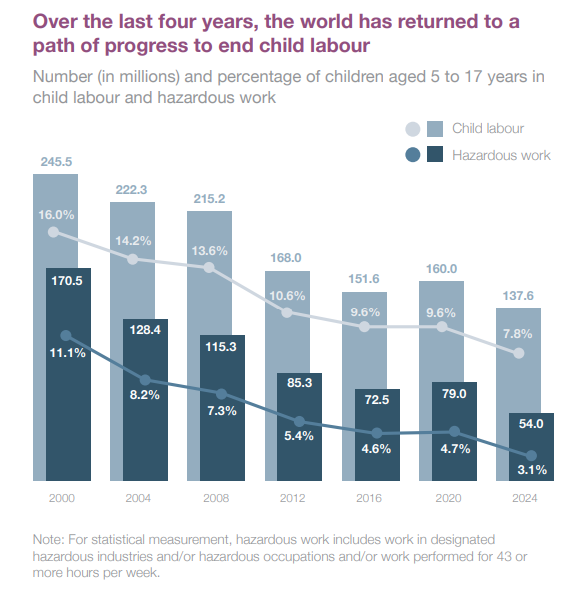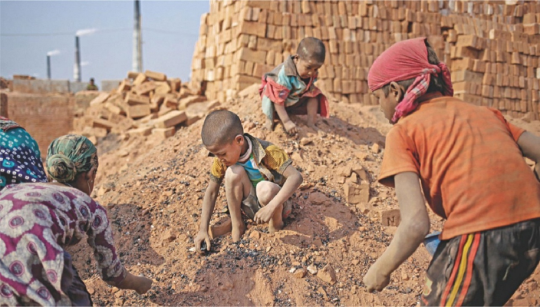While a new report shows a sharp decline in child labour in the Asia-Pacific region, the situation in Bangladesh is not the same.
The broader child labour rate (detrimental forms of work) remained relatively stable at 4.4 per cent in 2022, up marginally from 4.3 per cent in 2013, indicating that despite significant progress over the past two decades driven by increased school enrolment, Bangladesh is not on track to eliminate child labour by the 2025, according to new estimates released on Thursday by the International Labour Organization (ILO) and UNICEF, reports UNB.
Most working children remain in informal employment, often facing long hours and poor working conditions. This highlights the urgent need for sustained efforts to protect children across the nation, said the report titled ‘Child Labour: Global estimates 2024, trends and the road forward’.
Child labour compromises children’s education, limiting their rights and future opportunities, while putting them at risk of physical and mental harm.
“The findings of this global report, alongside our own data in Bangladesh, offer both encouragement and a call to action,” said Rana Flowers, UNICEF Representative in Bangladesh.
While they acknowledge the progress in reducing hazardous child labour in Bangladesh, Rana Flowers opined, the stagnant overall child labour prevalence tells us we have much more to do.
“Strengthening support to families, through a strengthened social protection system, ensuring universal access to quality education, and investing in social services including child protection services are critical.
“Children belong in schools and at play, not in the workforce, and we must collectively recommit to ensuring their rights are upheld,” she added.

While global efforts have led to a significant reduction in child labour, nearly 138 million children were engaged in child labour in 2024, including around 54 million in hazardous work likely to jeopardise their health, safety, or development, according to new estimates.
The report, released one day ahead of the World Day Against Child Labour and on International Day of Play, underscores a stark reality that while gains have been made, millions of children are still being denied their right to learn, play, and simply be children.
While there has been a commendable decline in hazardous child labour, from 3.2 per cent in 2013 to 2.7 per cent in 2022 (representing about 1.07 million children), the overall proportion of working children (ages 5-17) slightly increased from 8.7 per cent to 8.9 per cent during the same period.
Child labour compromises children’s education, limiting their rights and their future opportunities, and putting them at risk of physical and mental harm.
It is also a consequence of poverty and lack of access to quality education, pushing families to send their children to work and perpetuating inter-generational cycles of deprivation.
According to the global data, agriculture remains the largest sector for child labour, accounting for 61 per cent of all cases, followed by services (27 per cent) such as domestic work and selling goods in markets, and industry (13 per cent), including mining and manufacturing.
On the occasion of the World Day Against Child Labour, Gunjan Dallakoti, officer-in-charge of ILO Bangladesh, highlighted the importance of effectively implementing ILO Conventions, which Bangladesh has ratified, alongside national legal frameworks to eliminate child labour.
Expressing concern over the stagnation of progress in eradicating child labour, he emphasised the urgent need for renewed commitment through a whole-of-society approach. He stressed that meaningful progress requires coordinated efforts from communities, employers, trade unions, civil society, NGOs, and the media.
Reaffirming the ILO’s continued support, Dallakoti underscored that decent work cannot exist where child labour persists and called for collective action to ensure every child enjoys a safe, education-filled childhood.
To accelerate progress, UNICEF and ILO are calling for governments and stakeholders to invest in adaptive social protection following life-cycle based approach to cover vulnerable households, including through social safety nets such as universal child benefits, so families do not resort to child labour.
Alongside that, a call was made for strengthening child protection systems to identify, prevent, and respond to children at risk, especially those facing the worst forms of child labour. Providing universal access to quality education, especially in rural and crisis-affected areas, so every child can learn.
In addition, ensuring decent work and productive economic opportunities for adults and youth, including rights at work and access to resources was also called for as well as imposing stringent punishment and enforce laws and business accountability to end exploitation and protect children across supply chains.
Since 2000, child labour has almost halved globally, from 246 million to 138 million, yet current rates remain too slow, and the world has fallen short of reaching the 2025 global elimination target.
To end it within the next five years, the current rates of progress would need to be 11 times faster.


